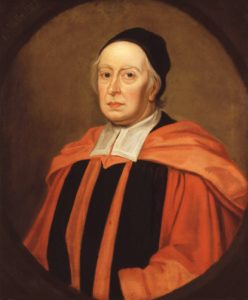
This tiny post is an invitation to play with hypergeometric functions. These remarkable special functions can be useful to all mathematicians. They are bizarely not known by many, however.
Newton binomial series. It states that for any $z,\alpha\in\mathbb{C}$ with $|z|<1$, $$\frac{1}{(1-z)^\alpha}=\sum_{n=0}^\infty(\alpha)_n\frac{z^n}{n!}\quad\text{where}\quad (\alpha)_n:=\alpha(\alpha+1)\cdots(\alpha+n-1)$$ is the Pochhammer symbol for rising factorial named after Leo August Pochhammer (1841 - 1920), with the convention $(\alpha)_0=1$ if $\alpha\neq0$. Note that $(1)_n=n!$ and $$\Gamma(\alpha+n)=(\alpha)_n\Gamma(\alpha)\quad\text{where}\quad\Gamma(\alpha):=\int_0^\infty t^{\alpha-1}\mathrm{e}^{-t}\mathrm{d}t.$$ When $\alpha=m$ then this boils down to $(m)_n=(m+n-1)!/(n-1)!$.
Hypergeometric functions. Inspired by the Newton binomial series expansion, they try to catch, via a unique parametrized series, a large variety of special functions. More precisely, if $a\in\mathbb{R}^p$, $b\in\mathbb{R}^q$, and $z\in\mathbb{C}$, $|z|<1$, then, when it makes sense,
$${}_pF_q\begin{pmatrix}a_1,\ldots,a_p\\b_1,\ldots,b_q\\z\end{pmatrix}:=\sum_{n=0}^\infty\frac{(a_1)_n\dots(a_p)_n}{(b_1)_n\cdots(b_q)_n}\frac{z^n}{n!}.
$$
We could use from this formula analytic continuation. Hypergeometric functions where studied by many including notably Leonhard Euler (1707 - 1783) and Carl-Friedrich Gauss (1777 - 1855). This kind of special function contains several others, for instance
- ${}_2F_1(1,1;2;-z)=\frac{\log(1+z)}{z}$
- ${}_2F_1(a,b;b;z)=\frac{1}{(1-z)^a}$
- ${}_2F_1(\frac{1}{2},\frac{1}{2};\frac{3}{2};z^2)=\frac{\arcsin(z)}{z}$
It is also possible to embed Jacobi orthogonal polynomials into hypergeometric functions and thus several families of orthogonal polynomials, more precisely $${}_{2}F_{1}(-n,a+1+b+n;a+1;x)={\frac {n!}{(a+1)_{n}}}P_{n}^{(a,b)}(1-2x).$$ Note that $(z)_k=0$ for large enough $k$ when $z$ is a negative integer, hence ${}_pF_q(a;b;z)$ is a polynomial when one of the $a_i$ is a negative integer.
Hypergeometric functions admit integral representations, and conversely, certain integrals can be computed using hypergeometric functions. Here is the most basic example.
Euler integral representation formula for ${}_2F_1$ published in 1769. If $a>0$, $b>0$, $|z|\leq 1$, then
$$\int_0^1u^{a-1}(1-u)^{b-1}(1-zu)^{-c}\mathrm{d}u
={}_2F_1\begin{pmatrix}a,c\\a+b\\z\end{pmatrix}
\frac{\Gamma(a)\Gamma(b)}{\Gamma(a+b)}$$ In other words, for all $a,b,c$ with $c>a>0$ and all $|z|\leq 1$,
$${}_2F_1\begin{pmatrix}a,b\\c\\z\end{pmatrix}=\frac{\Gamma(c)}{\Gamma(a)\Gamma(c-a)}\int_0^1u^{a-1}(1-u)^{c-a-1}(1-zu)^{-b}\mathrm{d}u.$$
A proof. A binomial series expansion of $(1-zu)^{-c}$ gives
$$
\int_0^1u^{a-1}(1-u)^{b-1}(1-zu)^{-c}\mathrm{d}u
=\sum_{k=0}^\infty\frac{(c)_k}{k!}z^k
\int_0^1u^{a+k-1}(1-u)^{b-1}\mathrm{d}u.
$$
Now the beta-gamma formula $\displaystyle \int_0^1u^{a+k-1}(1-u)^{b-1}\mathrm{d}u=\frac{\Gamma(a+k)\Gamma(b)}{\Gamma(a+b+k)}$ gives
$$
\int_0^1u^{a-1}(1-u)^{b-1}(1-zu)^{-c}\mathrm{d}u
=\Gamma(b)\sum_{k=0}^\infty\frac{(c)_k\Gamma(a+k)}{\Gamma(a+b+k)}
\frac{z^k}{k!}.
$$
Finally the formula $\Gamma(z+k)=(z)_k\Gamma(z)$ gives
$$
\int_0^1u^{a-1}(1-u)^{b-1}(1-zu)^{-c}\mathrm{d}u
=\frac{\Gamma(a)\Gamma(b)}{\Gamma(a+b)}\sum_{k=0}^\infty\frac{(c)_k(a)_k}{(a+b)_k}
\frac{z^k}{k!}\\
=\frac{\Gamma(a)\Gamma(b)}{\Gamma(a+b)}\ {}_2F_1\begin{pmatrix}a,c\\a+b\\z\end{pmatrix}.
$$
Immediate corollary. By sending $z$ to $1$, taking $b>c$, and using the beta-gamma formula $$\int_0^1u^{a-1}(1-u)^{b-c-1}\mathrm{d}u =\frac{\Gamma(a)\Gamma(b-c)}{\Gamma(a+b-c)},$$ we obtain the following identity discovered by Gauss (1812), for all $a,b,c$ with $c>a+b$, $$\sum_{k=0}^\infty\frac{(a)_k(b)_k}{(c)_k}\frac{1}{k!}={}_2F_1\begin{pmatrix}a,b\\c\\1\end{pmatrix}=\frac{\Gamma(c-a-b)\Gamma(c)}{\Gamma(c-a)\Gamma(c-b)}.$$
Maple, Mathematica, and Maxima. All implement hypergeometric functions. Here is an example with the Euler integral formula with Mathematica:
In[1]:= Integrate[u^{a-1}*(1 - u)^{b-1}*(1 - z*u)^{-c}, {u, 0, 1}]
Out[1]= {ConditionalExpression[
Gamma[a] Gamma[b] Hypergeometric2F1Regularized[a, c, a + b, z],
Re[a] > 0 && Re[b] > 0 && (Re[z] <= 1 || z ∉ ℝ)]}The regularized ${}_2F_1$ hypergeometric function used by Mathematica is ${}_2F_1(a,b;c;z)/\Gamma(c)$.
Further reading.
- George Andrews, Richard Askey, Ranjan Roy
Special functions (Theorem 2.2.1 pages 65)
Encyclopedia of Mathematics and Its Applications 71
Cambridge University Press. xvi, 664 p. (1999) - Rainville, Earl D.
Special functions.
The Macmillan Company, New York 1960 xii+365 pp - Kathy A. Driver, Sarah Jane Johnston
An integral representation of some hypergeometric functions
Electron. Trans. Numer. Anal. 25 (2006), 115-120.